Description
Buckwheat Germplasm in the World
Coordinators: Zhou Meiliang, Kreft Ivan, Suvorova Galina, Tang Yu, Woo Sun-Hee
Language: English
Subjects for Buckwheat Germplasm in the World:
Keywords
Aboveground mass; Accession; Adaptation; Amino acids; Amylose; Antibacterial; Anticancer; Antiinflammatory; Antioxidant; Antitumor; Biodiversity; Biomark; Biotechnology; Botanical description; Botanical nomenclature; Branching potential; Buckwheat; Buckwheat (Fagopyrum esculentum); Buckwheat breeding; Centers of genetic diversity; Chloroplast genome; Chromosomes; Classification; Collection; Common buckwheat; Conservation; Crop improvement; Cultivated Tartary buckwheat; Cultivation; Cultivation profile; Cymosum group; Determinant; Determinate habit; Differentiation; Diploid species; Diversity; Embryo rescue; Erosion; Evolutionary process; F homotropicum; F pilus; F tataricum; Fagopyrum; Fagopyrum cymosum; Fagopyrum esculentum; Fagopyrum esculentum Moench; Fagopyrum genus; Fagopyrum hailuogouense; Fagopyrum homotropicum; Fagopyrum statice; Fagopyrum tataricum; Fagopyrum tataricum (L) Gaertn; Fagopyrum urophyllum; Favorable traits; Flavonoids; Free amino acid; Functional food; Genetic diversity; Genetic germplasm; Genetic resources; Genotype; Genotype×environment interaction; Germplasm preservation; Germplasm resources; Global cultivation; Global distribution; Grain rutin content; Grain yield; Graminae crops; Green-flowering; Hairy root culture; Heterostyly; High performance liquid chromatography (HPLC); High-grained shortened central stalk; Hull; Improvement; InDel markers; Indian Germplasm; Interspecific hybridization; Interspecific hybrids; Karyotyping; Landraces; Medical; Meiosis; Min river valley; Mitosis; Molecular markers; Morphogenic callus; Morphotype; Mutation; Next generation sequencing; Nomenclature; Nonmorphogenic callus; Nutrients; Nutritional; Nutritional composition; Phenolic compounds; Photoperiod; Phylogenetic relationships; Phytochemical content
Support: Print on demand
Description
/li>Contents
/li>Biography
/li>Comment
/li>
Buckwheat Germplasm in the World offers an overview of this globally important crop, including its general characterization and genetic diversity?particularly in Russia, China, India and Eastern Europe. The book presents the latest research on molecular marker development, genetics and phenotype analysis of new wild buckwheat to examine the nutritional values of this pseudocereal crop. Due to its short growth span, ability to grow at high altitudes and the high quality of its protein content, buckwheat is considered an important crop for addressing global food needs. Ideal for researchers and advanced-level students seeking better understanding of the buckwheat germplasm.
1. Overview of buckwheat resourses in the world 2. Classification and nomenclature of buckwheat plants 3. Distribution of buckwheat resourses in the world 4. Chromosome of Fagopyrum 5. Description of cultivated tatary buckwheat 6. Description of cultivated common buckwheat 7. Perennial wild Fagopyrum species-Self-incompatible 8. Perennial wild Fagopyrum species-Self-compatible 9. Annual wild Fagopyrum species-Self-incompatible 10. Annual wild Fagopyrum species-Self-compatible 11. Annual wild Fagopyrum species-Partially self-compatible 12. Molecular evolution of wild species and cultivated 13. Utilization of wild buckwheat species 14. Buckwheat genetic resources in central Europe 15. Existing variability and future prospects of buckwheat germplasm in the Himalayan tract 16. Undefined title 17. Effective use of genome-wide markers to breeding for quantitative traits in common buckwheat 18. Genetic diversity of Russian buckwheat cultivars assessed from nuclear and organellar gene sequences 19. Genetic polymorphism of common buckwheat (Fagopyrum esculentum Moench.), formed from evolutionary mutation reserve of the cultivar 20. Cultivation of Fagopyrum tataricum and Fagopyrum esculentum in order to obtain raw material with high rutin content in the Far East of Russia 21. Phytochemicals and their biofunctional properties of different buckwheat germplasms for functional food 22. Rutin content assessment of Tartary buckwheat germplasm cultivated in Italy Topic: Grain rutin content evaluation of a collection of approximatively 100 F. tataricum accessions 23. Correlation between grain yield and rutin content in common buckwheat germplasm cultivated in Southern Italy 24. Buckwheat resources in the VIR (Russia) collection: Photoperiod response 25. Main morphological types of cultivated buckwheat populations in Russia 26. Interspecific crosses between Fagopyrum cymosum and other species through embryo culture techniques 27. Cell cultures of Fagopyrum tataricum as a source of biologically active phenolic compounds 28. Molecular genetics of Buckwheat and its role in crop improvement
Prof. Dr. Ivan Kreft (University of Ljubljana/Slovenian Forestry Institute, Slovenia)studied agronomy and biology in Ljubljana (Slovenia - Dipl. Eng. Agr., Teacher of Biol., PhD) and in Lund (Sweden - Fil. Kand., MSc.). After employments in Germany and Sweden, he was appointed as researcher and teacher at University of Ljubljana, where he was retired as Professor in 2012. Since 2003 he is a member of Slovenian Academy of Science and Arts. He was holding lectures at many Universities including Maribor, Križevci, Zagreb, Wien, Udine, Roma, Lisboa, Porto, Lund, Uppsala, Nitra, Minsk, several Universities in China, in Korea, and on several Universities in Japan. In the period 1992/93 he was Visiting Professor at Kyoto University, Japan, in 2001 he received a title of Visiting Professor at Shanxi University (Taiyuan, China), in April and May 2010 he was again in Japan, Visiting Professor at Kobe Gakuin University, Faculty of Nutrition, in Kobe. Since 2013 he is employed at the Slovenian Forestry Institute, Ljubljana, Slovenia. Field research on crops, especially buckwheat, and traditional food materials of plant origin
Head of the Laboratory of Genetics and Biotechnology
All-Russia Research Institute of Legumes and Groat Crops, Orel, Russia
Her research interests include genetics, interspecific hybridization, tissue culture, and molecular markers
Prof. Dr. Sun-Hee Woo (Chungbuk National University, Korea),
Research interests in Molecular Genetics and Breeding of Crops and Crop Functional Genomics and Proteomics . Awards
- Summarizes all the reported and distributed buckwheat species in the world
- Offers researchers the ability to exchange resources with each other to breed new cultivars
- Classifies buckwheat species based on perennial and annual from their growth span, and self-incompatible or self-compatible from their flower morphology and characterization
- Facilitates hybridization of different species




